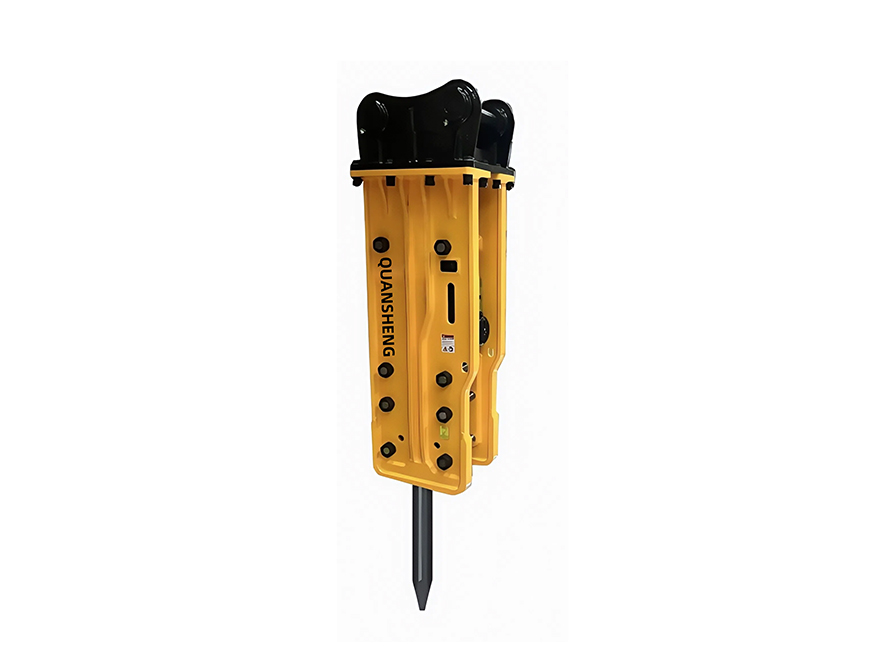Product
Classification

A hydraulic breaker, also known as a hydraulic pick or hydraulic hammer, is an engineering machinery accessory that uses pressure oil provided by the pump station of an excavator or loader as power to drive the piston to move back and forth. The piston impacts the chisel at high speed during the stroke, allowing the chisel to break solids such as ores and concrete.
Product Classification: Triangular hydraulic breaker, right-angle hydraulic breaker, silent hydraulic breaker.
Basic Structure
- Hammer Body (Movement Core): The core component of the hydraulic breaker, including the piston, cylinder block, control valve, etc. The piston moves reciprocally within the cylinder block, and under the control of the control valve, it achieves high-speed impact movement to generate breaking force.
- Bracket: Mainly supports and fixes the hammer body while guiding the chisel. The bracket is typically made of high-strength steel, with sufficient strength and rigidity to withstand the huge impact force generated during the breaker's operation.
- Accumulator: Mainly serves as a buffer to protect the breaker, extending its service life to a certain extent. Generally, small hydraulic breakers or those with a chisel diameter of less than 100mm (250px) are not equipped with an accumulator.
- Chisel: The component that directly contacts the material during breaking operations. It transfers the impact force of the piston to the material to achieve breaking.
Working Principle
The power source of a hydraulic breaker is the pressure oil provided by the pump station of an excavator or loader. The high-pressure oil output by the hydraulic pump station is transmitted to the hydraulic breaker through oil circuits. Inside the breaker, a special valve structure and piston design convert hydraulic energy into mechanical energy, enabling the piston rod to move up and down at high speed. The movement of the piston rod drives the chisel, whose tip is directed at the material to be broken. Through high-frequency impacts, the breaker crushes ores, rocks, etc.
Application Scenarios
- Construction and Demolition Projects: Used for demolishing concrete structures, brick-concrete buildings, or abandoned factories, especially in areas with limited space where blasting is infeasible. It can also be used for foundation excavation, breaking underground rocks or hardened soil layers to create conditions for pile foundation construction or pipeline laying.
- Mining and Quarrying: In mining, hydraulic breakers crush large rocks in ore veins for easier subsequent transportation and processing. They also perform secondary crushing on residual boulders after blasting to improve ore utilization. Additionally, they clear obstacles or collapsed rocks in mine tunnels.
- Road and Bridge Construction: In road construction, breakers remove damaged asphalt or concrete pavements for re-laying. In bridge construction, they break hard soil layers or weathered rock formations to enhance foundation bearing capacity. They also assist tunnel boring machines in handling hard rock masses during tunnel construction.
- Municipal Engineering and Public Facilities: In municipal engineering, breakers are used for pipeline laying, breaking underground rocks or permafrost during excavation. For municipal maintenance, they clear sewer blockages and demolish abandoned facilities. In subway construction, they handle obstacles in tunnels or reinforce the stratum.
- Metallurgy and Industrial Fields: In metallurgy, breakers crush solidified slag from blast furnaces and steelmaking furnaces for recycling. In industry, they decompose large metal scraps or industrial equipment.
- Emergency Rescue: In disaster relief, breakers quickly demolish concrete debris after earthquakes or collapses to open rescue passages. In traffic accident handling, they cut through deformed vehicle structures to rescue trapped personnel.